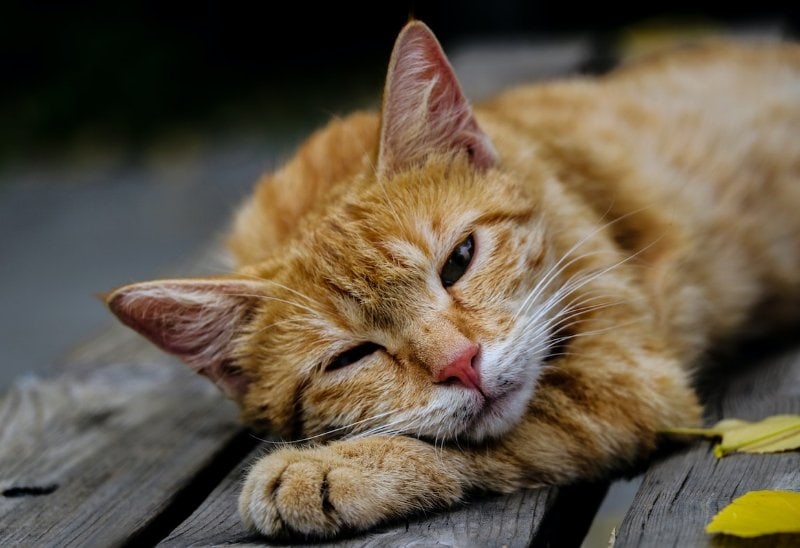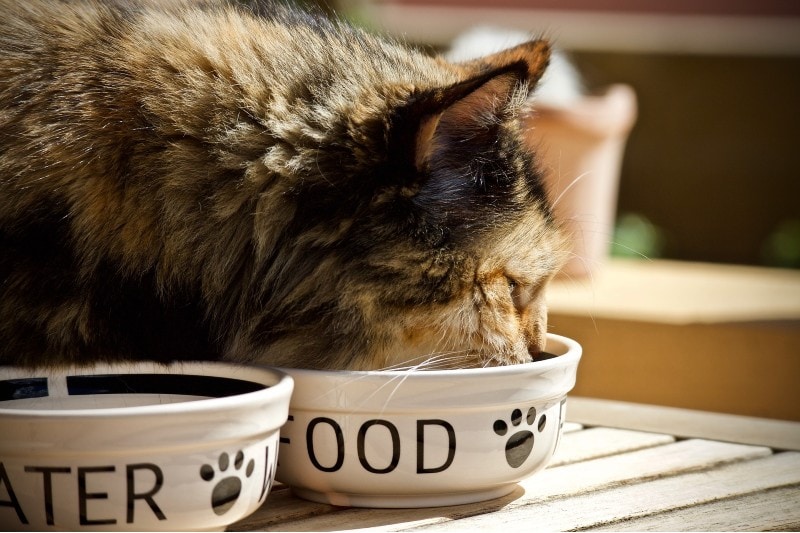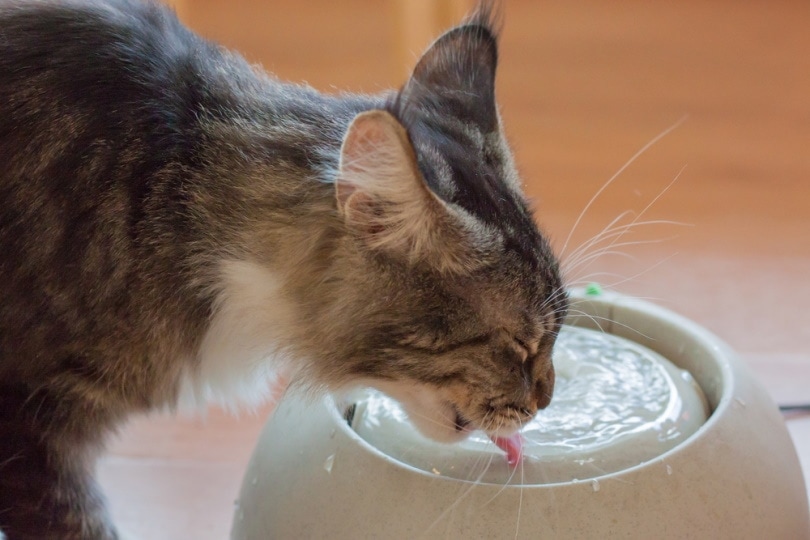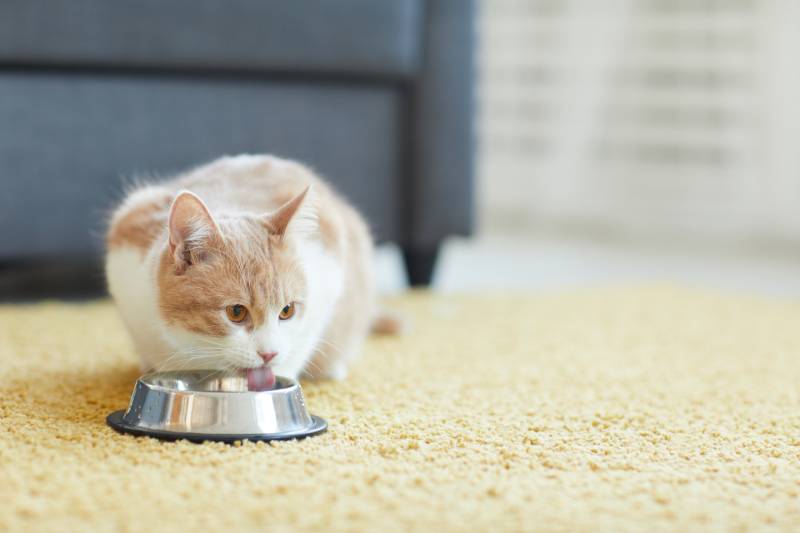
As a cat owner, providing a balanced diet and fresh water is critical to keep them healthy and happy. The question is, how much water does a cat need every day? The ideal daily amount is about 4 ounces per 5 pounds of body weight, or 0.88 fl. oz per pound.
This amount can vary based on several factors, including your cat’s age, how much activity they get, and several others. You can keep reading to find out more and help your feline stay hydrated and healthy. The information below will help you ensure your favorite furball is drinking enough H2O and provide tips to encourage them to drink more if necessary.
How Much Water Is Enough for Your Cat?
As mentioned, cats need about 4 ounces of water for every 5 pounds of body weight. So, for example, if your cat weighs 10 pounds, they’ll need about 8 ounces of water per day, equal to 1 cup. A 15-pound cat would thus need 1.5 cups of water daily to stay hydrated. BUT, the amount of water they actually drink will depend on a number of factors, including their health, their activity levels, and their diet.
Cats that eat more wet food than dry kibble will drink a lot less water than those fed dry food only. The table below can give you a rough guide of how much water a cat should be drinking each day, depending on what food they are eating.
| Approximate Water Requirement per Day | ||||||
| Weight
(lbs) |
Dry food only | Wet and Dry food | Wet food only | |||
| fl. oz | ml | fl. oz | ml | fl. oz | ml | |
| 5 | 4 | 114 | 2 | 57 | 0 – 1 | 0 – 28.5 |
| 10 | 8 | 228 | 4 | 114 | 0 – 2 | 0 – 57 |
| 15 | 12 | 342 | 6 | 170 | 0 – 3 | 0 – 85.5 |
| 20 | 16 | 456 | 8 | 228 | 0 – 4 | 0 – 114 |

How Can You Determine If Your Cat Is Drinking Enough Water?
You might think that putting the correct amount of water into your cat’s water bowl and ensuring they drink it all would be an easy way to make sure they’re getting enough water. The problem, however, is that most cats drink water from several sources, especially outdoor cats.
The reality is, it can be quite difficult to gauge how much your cat is drinking just by evaluating their water bowl, and the best way to know if your cat is drinking enough water is by looking at them.
If your cat is fit and well, and not dehydrated (more info. below), then they are likely getting enough moisture, either through their food or by drinking water. If you suddenly notice your cat spending more time in their water bowl or drinking water from taps, sinks, and water glasses, this could be a sign that something is causing them to drink excessively, and this is something that requires veterinary attention.
What Can Cause Your Cat to Become Dehydrated?
Many cat owners think that the only cause of dehydration is when their cat doesn’t drink enough water. However, several situations can cause dehydration in cats, including life changes, illnesses, and others. Below is a list of the most common causes of dehydration in cats.

What Are the Signs Your Cat Is Dehydrated?
Dehydration isn’t always easy to detect in cats, at least not in the initial stages. Indeed, until your feline friend is about 5% dehydrated, they might not show any signs of the condition. However, at 10%, your cat will likely be in bad shape, and by the time they reach 12% dehydration, meaning 12% of the water in their body has been lost, most cats will be in shock and close to death.
Knowing the signs of dehydration in cats can help prevent your cat from becoming ill and may save their life. Below are signs you will likely see, mild and severe, if your cat is dehydrated.
If you see any of these signs or a combination, you must immediately take your cat to your veterinarian. If your cat reaches 12% to 15% dehydration, the chance they will survive without immediate veterinary intervention is almost zero.

How To Ensure Your Cat Is Drinking Enough Water
This final section is particularly important, as we’ll give you several useful tips and advice on ensuring your cat drinks enough H2O every day. Some are easier than others, but all will be helpful.
1. Add Wet Food to Your Cat’s Diet
If you only feed dry food to your cat, give them more wet food. As the name suggests, wet food has more moisture than dry food, so your cat will drink while they eat. Wet food is between 70% and 80% water, and if you add 2 tablespoons of water to their wet food, you can be certain they are getting their moisture requirement for the day.
If your cat doesn’t like wet food, you can try adding water to their dry food. You can also add a teaspoon of bone broth, or the liquid from a can of tuna to their water bowl for extra flavor.

2. Use a Cat Water Fountain
One reason cats don’t drink from their water bowls is that the water is sitting still. In the wild, cats instinctively avoid still water in case of stagnation. A water fountain keeps the water moving, and most models include a filter to purify it. Plus, being curious, cats will likely be more attracted to a water fountain and drink more.
Keeping your cat hydrated can be surprisingly difficult. A filtered water fountain like Hepper's Stainless Steel Cat Water Fountain can provide your cat with safe, flowing water free from dangerous bacteria and bad smells.
This dishwasher-safe fountain features advanced triple filtration, three different flow modes, and a modern, minimalist design.
At Pet Keen, we've admired Hepper for many years, and decided to take a controlling ownership interest so that we could benefit from the outstanding designs of this cool company!
3. Use Multiple Bowls and Water Sources
In the wild, cats drink when they’re thirsty and look for water wherever they happen to be at the time. You can mimic this in and around your home by placing multiple water bowls and other water sources for your cat to take advantage of, including the water fountain we mentioned.
Cats will also avoid water bowls that are close to their food or litter box, in case of contamination. Keep their water bowls in a separate area, preferably somewhere quiet and out of the way.

4. Use Wide, Shallow Water Bowls
Cats have sensitive whiskers and, if their water bowl is too narrow, they may avoid it due to discomfort. Also, cats like to be able to see what’s around them when drinking; it helps them determine if they’re about to be attacked in the wild. For these two reasons, using wide, shallow water bowls for your cat’s water is best. Also, fill the bowl to the top since cats seem to prefer a full bowl.
Pet parents are faced with a few challenges when it comes to selecting new food and water bowls for their feline companions. The Hepper NomNom Cat Bowl combines cat-friendly features, such as shallow bowls and slight elevation that promote whisker relief, good posture, and digestion, with a beautiful modern design geared to keep floors free of mess during meal time. This bowl is entirely dishwasher safe, making life as a pet parent as simple as possible. Click here to learn why the Hepper NomNom Cat Bowl is right for you and your cat.
At Pet Keen, we’ve admired Hepper for many years and decided to take a controlling ownership interest so that we could benefit from the outstanding designs of this cool cat company!
5. Change the Water Source
Many municipalities have water with a strong chlorine smell that cats don’t like and will avoid. Consider buying bottled water or a filter if your pet dislikes tap water. You should avoid using bottled water that’s flavored, colored, or has electrolytes added.

6. Place Water Bowls in a Spot Where Your Cat Feels Comfy and Safe
A water bowl shoved in the corner is not attractive to cats because they can’t see what’s coming while they drink. While it doesn’t need to be in the middle of the floor, per se, moving your cat’s water bowl to a spot where they can position themselves the way they like is best.
7. Use Ceramic or Stainless Steel Bowls
Plastic bowls are more likely to accumulate bacteria and contamination, while ceramic and stainless steel are easier to clean, and also keep the water cooler.

Final Thoughts
Your feline friend needs around 4 ounces of water (½ cup) daily for every 5 pounds they weigh, depending on their health, age, activity level, and food type. That might not seem like a substantial amount, but it is the equivalent of a 170 lb human drinking 150 fl, oz per day. This volume may be met through drinking or consuming foods high in moisture. Without it, there is a risk of dehydration.
Providing wet food, a water fountain, and more water bowls (among other solutions) can help your cat get the water they need to stay fit and live a long, vibrant life. Remember, if you are worried that your cat is becoming dehydrated, or if they have started drinking excessive amounts of water, it’s time to call your vet.
See also:
- Dog Breeding Hygiene: 7 Important Tips
- How Often to Change the Water in a Cat Fountain: Vet-Approved Advice
Featured Image Credit: Punyaphat Larpsomboon, Shutterstock








